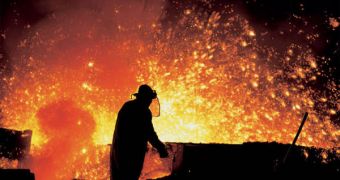In a study that would have been considered witchcraft, or alchemy at best, a few centuries ago, researchers at the California Institute of Technology (Caltech) have managed to create metal alloys that do not exhibit the basic property of metals, namely the ability to expand when subjected to heat. In addition, the newly obtained materials act like metals with a completely different internal physical structure than the elements they were made out of. The experiments are described in the latest issue of the respected scientific journal Physical Review Letters.
This line of research could have significant and widespread consequences for the way we understand the solar system and the Universe, as more than 90 percent of all matter around our planet is, in some form or another, subjected to extremely high pressures. This was the method used by the Caltech team to obtain the new materials – they subjected regular metals to pressures hundreds of thousands of times greater than the one our atmosphere exerts on us. The first such material was found in 1896 by Swiss Physicist Charles Édouard Guillaume, who won the Nobel Prize in Physics for it in 1920, besting Albert Einstein. The famed physician won the prize a year later, in 1921.
Guillaume named his inexpensive iron-nickel alloy “Invar,” short for “invariant,” the property that the metals had of not expanding when heated. Admittedly, his material did expand a little when subjected to large amounts of heat, but he managed to demonstrate at the time that the concept was real, and that it could be built upon. According to modern knowledge, the behavior of Invar materials is caused by unusual changes in their magnetic properties, which cancel the usual expansion effect. When heated, atoms inside metals become “agitated,” and move apart from each other, causing expansion.
“Recent computer simulations indicate that electrons in Invar alloys take on a special energy configuration. This energy state is at the borderline between two types of magnetic behavior, and is very sensitive to the precise ratio of elements that make up the alloy. If you move away from the Invar chemical composition by only a couple of percent, the energy configuration will disappear,” the first author of the recent journal paper, Caltech graduate student Michael Winterrose, explains.
“Our initial results from these studies showed that the alloy stiffened under pressure, but far more than we expected. The simulations showed that under pressure, the electrons found the special energy levels between strong and weak magnetism that are associated with normal Invar behavior. Up to this point we had been quite unaware of the possibility for Invar behavior in our material,” Winterrose says. For the new experiments, the Caltech team used Pd3Fe, an alloy of palladium (Pd) and iron (Fe).
“Today, materials physics has some excellent computational tools for predicting the structure and properties of materials, although there are suspicions about how well they work for magnetic materials. It is satisfying that these computational tools worked so well for showing how pressure changed the material into an Invar alloy. Invar behavior is pretty subtle, requiring a very special condition for the electrons in the metal that is usually tuned by precise control of chemical composition. Pressure can make the electrons behave as if they are in a material of different chemical composition, so I really like Mike's use of the word 'alchemy,'” Caltech Professor of Materials Science and Applied Physics Brent Fultz, also a co-author of the new paper, concludes.

 14 DAY TRIAL //
14 DAY TRIAL //